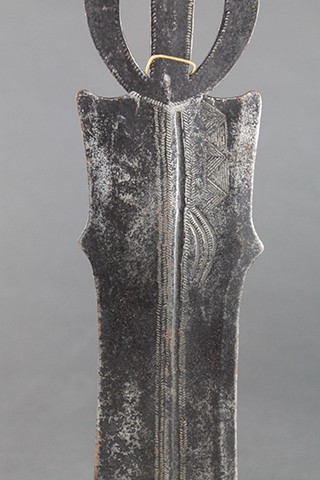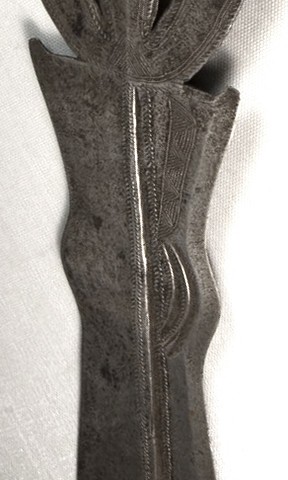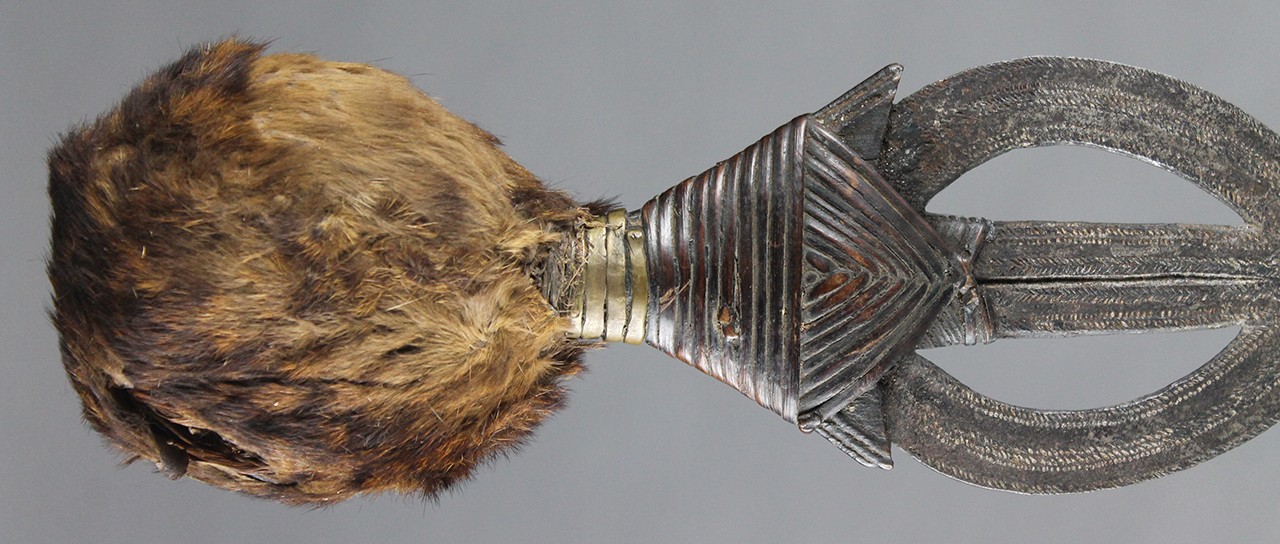© 2023 Kreativa. All rights reserved. Powered by JoomShaper
All Swords of Things: Five Decorative Short Swords from the Congo
 |
| Swords, 19th to 20th Century Ngombe or Poto culture; Democratic Republic of the Congo Wood, leather, metal, fur and fiber F79.58.2, F80.49.26, F79.59.2, 2003.42.29 and 2013.12.3 Gifts of Dr. and Mrs. Myron Klapper, Mr. and Mrs. Jon Herman, Dr. and Mrs. Iwao Kawakami, Susan Lerer and David Poiry |
Old Knives Tale
Swords once played a vital role in warfare as objects of power and intimidation. They made their way into our oral history and folklore with tales such as such as King Arthur and the legendary Excalibur. In fact, cultures from around the world have forged these famous weapons into countless permutations of shape, size, design, and even function. The five objects highlighted in this post are examples of 19th to 20th Century decorative short swords from the Congo region in Central Africa. These Congolese swords serve a multitude of purposes, require an assortment of special talents to create, and, like Excalibur, are also associated with magical powers.
 |
 |
| Detail of 2013.12.3 Gift of David Poiry |
Poto. Sword, 19th century. Iron, wire, 4 3/4 x 21 7/16 in.. Brooklyn Museum, Museum Expedition 1922, Robert B. Woodward Memorial Fund, 22.442. Creative Commons-BY (Photo: Brooklyn Museum) |
Looking Sharp
Several peoples have been associated with the manufacturing and use of these swords including the Ngombe and Poto speakers of the Democratic Republic of the Congo. However, the characteristic markings of each sword might help distinguish them as being made by one group or another. Three of the objects have a specific geometric engraving as well as a protruding ridge on each side of the blade. In comparison, the other two objects do not have the same designs or the additional ridges. The differentiation of these stylistic attributes might indicate that these two groupings of swords came from two different cultural groups.
The geometric patterns seen on most of these blades are intriguing due to the amount of detail and their consistent shape. It is clear from the sheer number of swords bearing the marking both within and without the Bowers’ collections that it was not an arbitrary aesthetic flourish. It could be that this design acts as an ideogram connected to symbolic tribal markings found on important individuals or it could have emblematic meaning that we are unable to decipher.
 |
| F79.58.2 Gift of Dr. and Mrs. Myron Klapper |
Definitely Not Pointless
Just by looking at these swords, it is obvious that their purpose exceeds physical harm. A blacksmith would be primarily concerned with ensuring a sword was strong, balanced, effective, and easy to maneuver before he would be concerned with beautification. While these five objects contain functional offensive and defensive elements, their supplemental decorative embellishments suggest they were likely used to glorify its owner. Owning an item as unique as this would signify your status, rank, title, and/or function to the rest of the society. Furthermore, it has also been suggested that these swords were utilized as marriage currency for the Gonji Ngombe.
 |
| Detail of F79.59.2 Gift of Dr. and Mrs. Iwao Kawakami |
The Cutting Edge
The mediums and techniques required in the creation of these swords also suggest that they were not common items. The construction of the blades and additional metal wrappings around the grips requires complex metal working; the weaving of the organic fibers involves basketry; and the triangular wooden grips demonstrate a carver’s prowess in woodcarving.
Within the Ngombe people, the only craft that is recognized as a specialty is ironworking because it requires not only the abilities of a blacksmith but also the knowledge of secret medicine. Medicines and organic materials are frequently used within Ngombe daily life to help with protection, health, and aid in good luck in activities like hunting. The use of medicines is also present within these items. During construction, magical substances are wrapped in animal hide and used to give the sword its power.
 |
| Details of 2013.12.3, 2003.42.29 and 79.59.2 Gifts of David Poiry, Susan Lerer and Dr. and Mrs. Iwao Kawakami |
Penny Fur Your Spots
It has been proposed by the Smithsonian that the material used for the swords' pommels is made of leopard or civet cat skin. The fur of these cats is a prized possession and was used in several elements within Ngombe culture to signify a person’s societal rank. Additionally, Ngombe chiefs have the right of first refusal for certain animals including the leopard, python, specific birds, crocodile tail, and elephant trunk. The application of leopard pelt on the pommels may suggest their connection with people of dignitary status. While leopard was most likely used in these pommels of the Bowers swords, the large cat hide has yet to be formally identified.
Post researched and guest co-written by Annya Jacobs, Volunteer for the Bowers Museum Collections Department. Text and images may be under copyright. Please contact Collection Department for permission to use. References are available on request. Information subject to change upon further research.

Comments 1
Thanks you very much in an honor for me from France 🇫🇷🙏